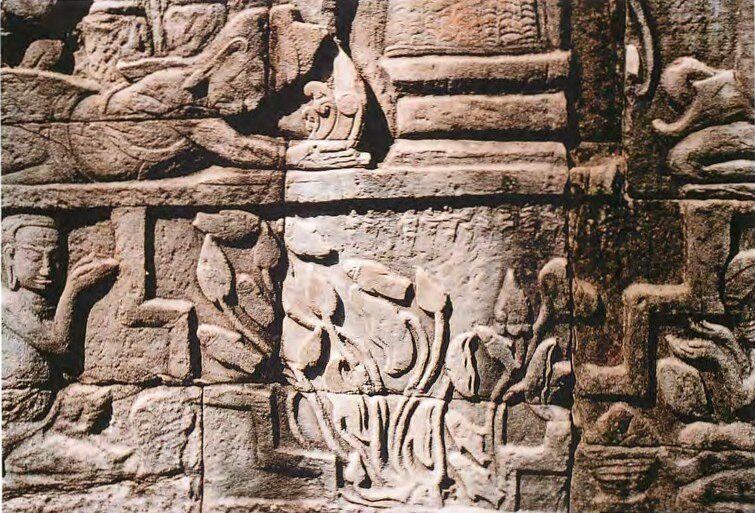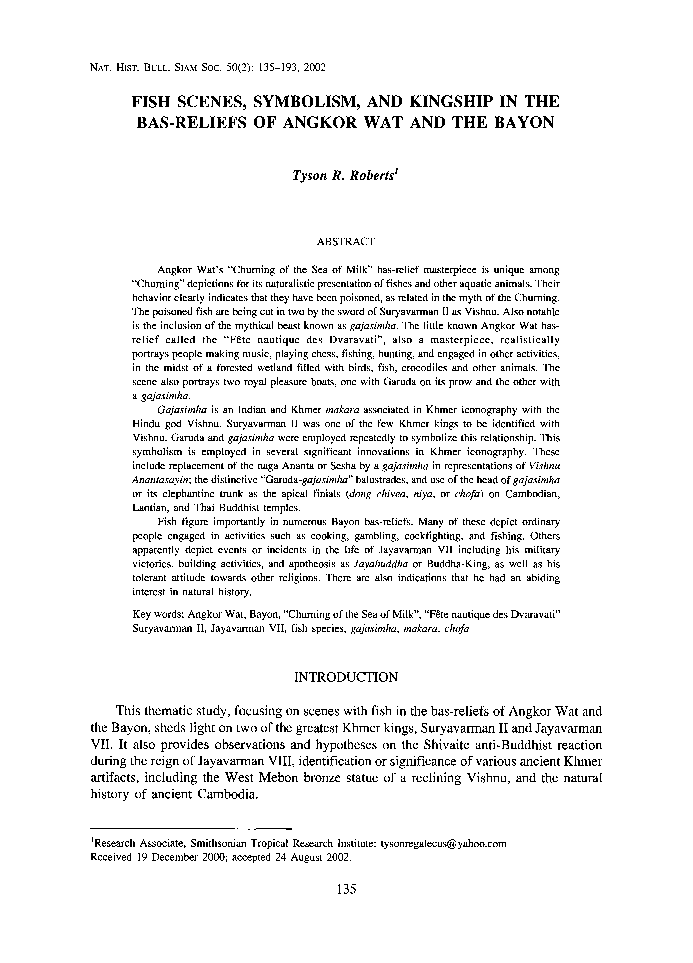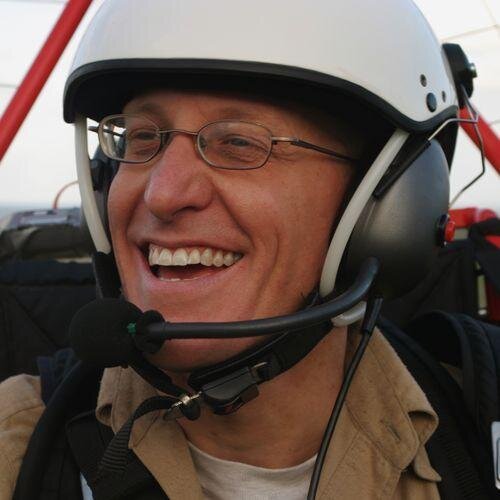While studying fish species in Cambodia from 2001 to 2004, the scientist developed a keen interest in Angkorean bas-reliefs and representations of the major Khmer devarajas (god-kings). A true Renaissance man, he applies his scientific expertise to develop a stimulating approach of ancient Khmer art and symbols. Particularly insightful are the following remarks from this fascinating study:
- “Gajasimha [lion with a fish snout] is an Indian and Khmer makara associated in Khmer iconography with the Hindu god Vishnu. Suryavarman I was one of the few Khmer kings to be identified with Vishnu. Garuda and gajasimha were employed to symbolize this relationship. This symbolism is reflected in several significant innovations in Khmer iconography. These include replacement of the naga Ananta or Sesha by a gajasimha in representations of Vishnu Anantasayin; the distinctive “Garuda-gajasimha” balustrades, and use of the head of gajasimha or its elephantine trunk as the atypical finials (dong chivea, niya, or chofa) on Cambodian,Laotian, and Thai Buddhist temples.”
- “Fish figure importantly in numerous Bayon bas-reliefs. Many of these depict ordinary people engaged in activities such as cooking, gambling, cockfighting, and fishing. Others apparently depict events or incidents in the life of Jayavarman VII including his military victories,building activities,and apotheosis as Jayabuddha or Buddha-King,as well as his tolerant attitude towards other religions. There are also indications that he had an abiding interest in natural history.”
- “Two reviewers state categorically that the Vishnu of West Mebon dates from the time of the Baphuon and the reign of King Udayadityavarman II. That would be in the middle of the eleventh century and a half-century too early for Suryavarman Il. While I certainly agree that the relatively small part of the perimetral wall still standing on the West Mebon has bas-reliefs that are typically Baphuon style, it seems highly likely another king or kings including Suryavarman II sent architects and builders to the same site. They may have added new structures,n ew inscriptions,and new statues here as they did at many other temples,and especially during the reign of Suryavarman II (1113- ca 1150).”
- “Some of the most skillful and accurate fish portrayals occur in parts of the Angkor Wat Churning of the Sea, where we can readily identify the predatory catfish Wallago attu and tongue-soles of the genus Cynoglossus. In these two instances it seems likely that the sculptors or other artisans who drew the fish on stone for the sculptors worked from actual fish specimens (either fresh fish or,more likely in the case of Cynoglossus, dried fish).”
- The following fish taxa are identifiable in the bas-reliefs of Angkor Wat and the Bayon: Pristidae (sawfish): Pristis microdon | Notopteridae (featherbacks): Chitala and/or Notopterus | Cyprinidae (carps) Bangana behri?, Hypsibarbus spp, Labeo pierrei? | Pangasiidae (catfish): Pangasius hypophthalmus?; Pangasius lamaudei?; Pangasius sanitwongsei? | Siluridae (catfish): Wallago attu | Channidae (snakeheads): Channa | Synbranchidae (swamp-eels or smooth perch-eels): Monopterus javanensis | Soleida(flatfish or soles): Euryglossa; Cynoglossidae (tongue soles); Cynoglossus.”
King Jayavarman VII and the Biosphere
“The Bayon bas-reliefs include scenes that suggest Jayavarman VII had an abiding interest in nature. There is the elaborate scene of wild animals (including rhinos and perhaps one or two extinct mammal species) in the royal menagerie (GROSLIER). The sacred pond or royal aquarium is full of captive fish. There are depictions of diverse fish and aquatic life in the Chinese river cruise and naval battle scenes; and many other pond, river, and forest scenes with fish, turtles, crocodiles, wildfowl and mammals. There is the touching scene of a young Jayavarman VII (if indeed it is him) raptly gazing at fish in the moat before the statue of Vishnu…
“To the evidence of naturalist leanings from the Bayon bas-reliefs may be added a quote from an inscription about Jayavarman VII from Preah Khan. This nscription, dated 1191,states:“To the multitude of his warriors he gave the capitals of enemy kings,with their shining palaces; to the beasts roaming his forests,h e gave the forests of the enemy; to prisoners of war,he gave his own forests. Thus did he manifest generosity and justice” (after CHANDLER,1983: 60). The second of the three sentences in the quotation indicates Jayavarman VII established the equivalent of our modem protected forests and wildlife sanctuaries. This corresponds to forest practices in Indian or Kautiliyan principles of “Arthashastra” or good govemance dating back at least as early as the Mauryan Empire in the third century BC (RANGARAJAN,1992).
“Evidently Jayavarman VII appreciated and cared for nature. He would have been thrilled by the discovery of such stunning endemic Mekong fish as the giant predatory carp Aaptosyax grypus and the giant buck-toothed giant goramy Osphronemus exodon. The present greatly reduced and impoverished condition of the Cambodian forests and the disappearance or scarcity of rhinos, forest birds and other animals would distress him.”
Where did the famous Jayavarman’s naval battle actually take place?
“The presence [on the bas-reliefs depicting the scene] of individuals of a large bump-headed carp,identified here as the Mekong endemic species Bangana behri, is relevant. This large and distinctive species is unknown from the Great Lake. It occurs in the Mekong mainstream,mainly in rapidswith extensive rocky bottom,far upstream from Phnom Penh. The southemmost part of its usual habitat is not precisely known, but is thought to be in the vicinity of Kratie. This suggests that the battle might have taken place in the swift-flowing stretch of the Mekong mainstream extending from Stung Treng to Kratie, well upstream from Kompong Cham. It may be speculated that Jayavarman VII permitted the Chams defeated in the naval battle to settle in the area now known as Kampong Cham,and that he had Vat Nokor constructed for them in the hope that they would be good Buddhists and peaceful citizens.”
About freshwater dolphins
- “There apparentIy are no depictions of dolphins in the bas-reliefs of Angkor Wat or the Bayon or of any other ancient Khmer temples. The bottle-nosed species Orcaella brevirostris reportedly was common in the Great Lake [Tonle Sap Lake] before relentless persecution by the Khmer Rouge in 1975 – 1979. It was common in the Se San (the large Mekong tributary in north-eastem Cambodia) until the construction of Vietnam’s Yali hydropower dam on the upper Se San in 1998. It is still present in the Mekong mainstream between Khone Falls in southem Laos and Kratie in Cambodia (pers. obs.) but prospects for its continued survival in the Mekong basin are not bright.”



